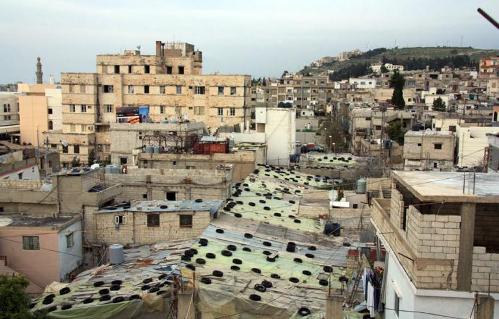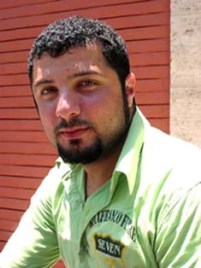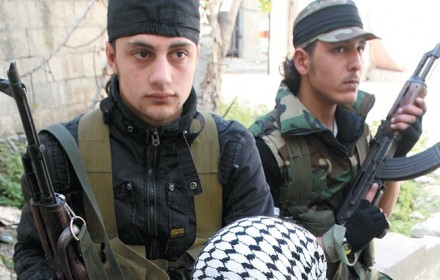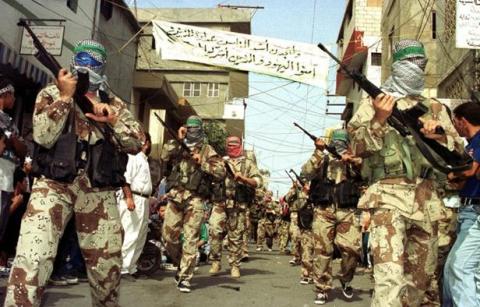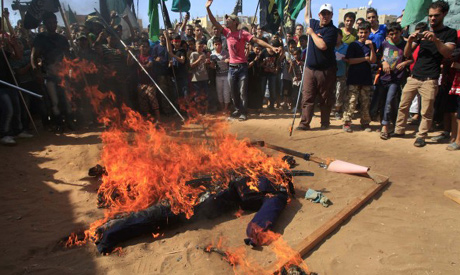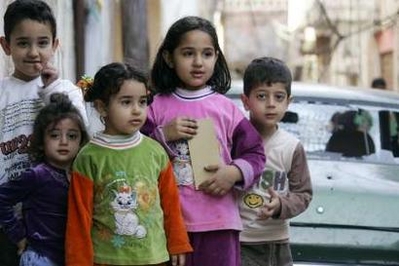Editor's comment: This article by Franklin Lamb may be a little difficult to follow, partly due to the twists and turns of his long sentences. It also may be difficult reading, especially for those who are unfamiliar with the struggle of the Palestinian refugees, because it is packed with a trove of information about the plight of 20,000+ Palestinians who have been driven out of Syria into refugee camps like Ain al Helweh. There are more ways to punish Palestinians ... for being Palestinians ... than bombing, shooting and starving them. Other methods include deportations from western countries of the US, Canada and Europe - and creating wars in countries like Syria forcing them to leave their homes and as refugees again to seek shelter in squalid, violent camps like Ain al Helweh, Lebanon. The Ain al Helweh "camp" is a slum for Palestinian refugees displaced by the creation of the state of Israel. Moreover, the 150-200 higher education scholarships for Palestinian youth in Lebanon this year may seem to be insignificant considering the tens of thousands of young people seeking to better their lives but as one teenage volunteer in Ain al Helweh told a reporter, it is "a project of resistance and to help our society we will try to the best of our ability.” - Les Blough, Editor Axis of Logic
Franklin Lamb in Beirut - A modest tempest is brewing in Lebanon among some supporters of Palestine and the US State Department over the decision by the Sabra-Shatila Scholarship Program (SSSP), the newly founded, and American donor-funded, higher education initiative, which intends to grant an additional 150-200 tuition scholarships to Palestinian students for spring semester enrolled in Lebanon’s dozen colleges and universities. The SSSP stipend applicant pool includes some of the more than 20,000 Palestinian refugees from the Syrian crisis, approximately 35% of whom are now sardine-canned in the Palestinian Refugee camp in Saida, Ain al Helweh. The largest and historically most violent of Lebanon’s 12 camps, Ain al Helweh’s name, which means “sweet water spring”, was chosen by UN staff after a nearby stream when the camp was established following the 1948 Nakba and its name also derives from the Emirate Ain al-Hilweh from the Ottoman period. The thousands of recent forced arrivals, (Yarmouk camp is Damascus is now 90% percent emptied of its pre-crisis population of more than 160,000) exist sometimes almost literally on top of one another according to the camp popular committees. Most of the apartments in Ain al Helweh are currently sheltering four to six families. Camp officials estimate that before the Syrian crisis the camp population was nearly 100,000, which is nearly twice the number of refugees in Ain al Helweh that research sources such as Wilkpedia list. Today’s camp population exceeds 122,000, camped on 1,500 sq. meters and was originally built to hold 20,000.
Because there is not enough food, shelter or clean water for the Palestinians from Yarmouk and other camps in Syria pouring into Lebanon and the camp, the desperation inside parts of Ain el Helweh render it ripe for exploitation by drug dealers, pimps, gunmen recruiters, body parts brokers and religious extremists. Not just educational assistance is needed, but repairs of the main and secondary water supply system, upgrading the main and secondary sewerage system, constructing new storm water and drainage system, updating and reinstating all roads and pathways of the south district of the camp and many other infrastructure and social problems need addressing in Ain al Helweh and in all of Lebanon’s other camps. With a predictability that Ivan Petrovich Pavlov, the Russian physiologist would understand, the US Zionist lobby including the Weekly Standards William Kristol, the notorious Islamophobe Danial Pipes and his Campus Watch witch hunters, as well as the Washington Post’s columnist, anti-Arab Charles Krauthammer, accuse the SSSP of giving college aid to “potential Palestinian terrorists” in Lebanon. Despite these silly defamatory rants, the US government’s problem is not that it harbors objections to helping Palestinian refugee students continue their education, or that higher education necessarily leads to terrorism. Rather Washington’s great concern, according to the media office of the US Embassy in Beirut, is the location of the Scholarship Award Event which is scheduled for late February in Ain al Hilweh camp. Ms. Zeinab al Hajj, an indefatigable longtime activist committed to improving the lives of her countrymen in Lebanon’s squalid camps and who was born and raised in Shatila escaping death during the 1982 massacre only through a miracle, is SSSP’s Executive Director. She concedes that the US Embassy has repeatedly expressed its objection to any Americans even entering Ain al Helweh and that it has instructed the Lebanese Army which surrounds the camp, to bar them. Zeinab explains to visitors that Ain al Helweh, is nicknamed by many as the “capitol of the diaspora” to honor the camps resistance to various aggressions against Lebanon over the years but that it is also labeled by some in the local media as a “zone of unlaw” because they claim that many people wanted by the Lebanese government are believed to have taken refuge in the camp as a result of the lack of Lebanese authority. Camp officials, and some NGO’s working in Ain al Helweh, dispute this charge explaining that it’s wildly exaggerated and that in any event Lebanon is full of safe havens for fugitives. What concerns some are about stability in Ain al Helweh are the sheer number and variety of factions and militia. A very recent survey was conducted by the SSSP and constitutes what may be the most comprehensive and definitive list published to date. The survey was completed on 11/13/13. Among the PLO factions in Ain al Helweh are the Democratic Front for the Liberation of Palestine (DFLP), the Popular Front for the Liberation of Palestine (PFLP), the Popular Liberation Front, the People’s Palestinian Party, Palestinian Popular Struggle Front, the Arab Liberation Front and the Democratic Palestinian Union (Fida). Pro-Syrian factions include, but are not limited to, the Popular Front for the Liberation of Palestine-General Command, Saiqa, and Fatah Intifada.
Among the Islamic factions operating inside Ain al Helweh are the Ansar Islamic League, Mujahid Islamic Movement, Islamic Resistance Movement (Hamas), Al Jihad al Islamic Movement, Jund al Sham, Fateh al Islam, Association of Islamic Charitable Projects, about a dozen of small al Qeada affiliated groups as well as some that represent Jabat al Nusra, according to camp officials. In addition the teeming camps hosts nearly 50 popular unions, youth and women organizations and sports teams. Ain al Helweh is divided into eight geographic security zones, some notorious, controlled by the larger and stronger groups.
Some argue that increasingly these days, five countries, influence the Lebanese army in various ways– the United States, Saudi Arabia, Syria, Iran and to a lesser extent in some respects, Lebanon itself. Consequently US instructions to the army command are taken seriously and when an American tries to enter Ain al Hilweh “legally” they are strongly discouraged, but not currently barred, if they can first secure a “visa” from the government or a letter from the US Embassy.
No doubt the warnings of the US and EU about potential violence, kidnappings for ransom and various paybacks for US military, including drone operations in the region, as well as snipers, are well intentioned and legitimate in order to protect American citizens. The US State Department argues that some of the 30 plus militia in the camp are also opposed to higher education, especially for women, and therefore some extremists might interfere with the scholarship event. But Manal S. who lives in Saida with family in the camp points out that SSSP has set up a committee inside the unsettled camp to prepare the event Hall and other arrangements for the spring semester scholarship award event. She explains that those arrangements include militia briefings and seeking pledges from some of the main ones that they will not to interfere with their fellow countrymen receiving tuition aid, despite some fairly bizarre Talabanic interpretations of the Holy Koran which some claim forbid female education. Why focus spring semester on scholarships for Ain al Helweh camp? Because Ain al Helweh has the highest school dropout rates, the highest rates of shootings and domestic violence, the highest rates of selling body parts to survive, and its future will be determined by the achievements of its young people who number more than 40 percent of Lebanon’s largest camp's population. Because there is not enough food, shelter or clean water for the Palestinians from Yarmouk the desperation inside parts of Ain al Helweh render it ripe for exploitation by drug dealers, pimps, gunmen recruiters, body parts brokers and religious extremists. Of course, not just educational assistance is needed, but repairs of the main and secondary water supply system, upgrading the main and secondary sewerage system, constructing new storm water and drainage system, updating and reinstating all roads and pathways of the south district of the camp and many other infrastructure and social problems need addressing in Ain al Helweh and in all of the other camps. According to recent UNRWA-funded study and various recent estimates, school dropout rates across Lebanon for Palestinian refugee children ten years and older average more than 40%, or ten times that of Lebanese children (CSUCS, 2007).
The SSSP, after much discussion, chose Ain al Helweh camp for spring semester scholarship because it’s where there exists, arguably the most urgent need to aid current and future college students who today are under increasing pressure in this violent and ever more confessional region to choose a Kalashnikov—over College which they cannot afford, in exchange for $130 a month and free cigarettes, the current ‘salary ‘in Lebanon for all manner of gunmen employed by various so-called “political parties.” The Sabra-Shatila Scholarship Program believes that it can help Ain al Helweh youngsters and send a positive message to Palestinians in Lebanon and elsewhere to resist the temptation to drop out of school and to instead, pursue higher education. SSSP seeks applications from across Lebanon and each semester brings its circuit scholarship award event to one of the 12 camps, because it believes SSSP must travel around Lebanon to the camps rather than require students to travel, sometimes with barriers for Palestinians en route, from the far North and deep South, all the way to Beirut. The first two SSSP tuition grants events were held last April in Shatila camp and the second last month in Burj al Barajneh camp. Ms. Hajj explains that SSSP does not limits its aid to her fellow refugees who have the highest GPA’s on the Baccalaureate II exams, but rather SSSP intentionally seeks out Palestinian refugee students, as long as they passed the “Bacc” who without tuition aid may well give up on the idea of seeking higher education. Asked by a reporter during the most recent SSSP scholarship event whether the American donor funded efforts can fix all that? “Not a chance!” answers Reem, a precocious and charming teen-age SSSP volunteer from Ain al Helweh who wants to study engineering, ”but as a project of resistance and to help our society we will try to the best of our ability.” Suha, a SSSP (sssp-lb.com) volunteer joked the other day that to a group of visiting Americans:
(All photos, captions and commentary by Axis of Logic) Franklin Lamb volunteers with the Sabra-Shatila Scholarship Program (SSSP) in Shatila Camp (www.sssp-lb.com) and is reachable c/o fplamb@gmail.com |
